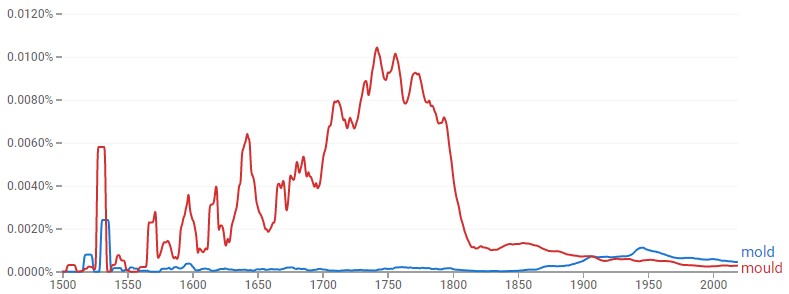When leaving damp towels in the dryer, they can quickly grow mold or get mouldy… or you just might prefer a nice mould for that jello salad. Curiously enough, every word in the sentence above is used properly in both spelling and meaning, but you might be asking both how and why.
Now that you are nice and confused, let’s look at the various ways you can use mold vs. mould, and why the spelling is different even when the many different meanings are not.
Is it Mold or Mould?
Mold and mould are alternative spellings of the same word, but mold is an American form, while mould is popular as a British spelling. Both can mean a furry growth of fungal hyphae; soft, loose earth; a hollow container used to give shape; or a distinctive style, form, or character.
Origins and Usage

The origin stemmed from the Latin word modulus and was embraced in late Middle English as both mould or mold and originally was used to describe something that grew mouldy or encouraged organic like growths. Multiple meanings of the word came into use through the years despite both spellings being used, but mould was the more popular form in the US and Britain until the early 1900s.
At this time mold began to gain traction as the more accepted form in the English language, possibly due to the printing and popularity of Merriam Webster’s dictionary publications. In America, mold is the more commonly accepted version, while mould is still well used through the UK and Canada.
Of course, the spelling difference extends to derivatives such as moldy/mouldy and molding/moulding and to the verb sense to shape with a mold/mould.
Singular vs. Plural Uses
It is easy to assume mold/mould can be used as both a singular and plural form, but to do so would be incorrect. The following is correct for singular and plural use:
SIngular:
Mold/Mould
Plural:
Molds/Moulds
Meanings
Mold (or mould) can be used as a noun and a verb.
As a noun, it can mean either a fungal organic matter that grows in damp or humid conditions or a container that shapes a molten liquid as it solidifies.
For example:
- After forgetting the towels in the washer, they had begun to grow mold.
- I poured the liquid epoxy into the mold to form a new keychain.
As a verb, mold means to form or reshape something.
For example:
- His actions helped mold him into something new and exciting.
- Use your energy to help mold your understanding of a new topic.
It also is often used figuratively to refer to a recognizable form or convention.
For example:
- She didn’t fit the mold of the candidates that came before her and brought new ideas to the campaign.
- He used the mold of those who came before him to influence a new style of art.
Examples of Mould and Mold in a Sentence
U.S. Publications
Inside, the rain had spawned black, green, and yellow mold that crawled the walls. [Atlantic]
Obama has been more in the mold of George H.W. Bush and his secretary of state. [Daily Beast]
If some of the insulation is intact, leave it in place unless it is moldy. [Boston Globe]
Outside the U.S.
Without air conditioning in a highly humid climate, mould could form. [Montreal Gazette]
And Pretty Ballerinas is still making shoes in the mould of the original pair created in 1918. [New Zealand Herald]
There’s no bread, and even the mouldy cheese has been chipped away at. [Scotsman]
Let’s Review
Mold and mould are both spelled correctly, but mold is more often used in America, while mould may be seen in the UK, Canada, and other countries that have embraced British spelling and use of words – such as Australia and New Zealand.
It can be used as a noun or verb, and any and all derivatives of the word embrace the spelling differences as well!
